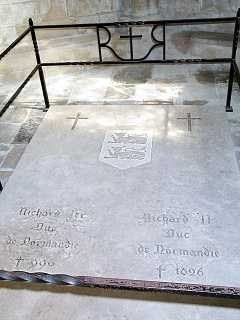He was the son of William I "Longsword" Duke of Normandy. A minor at the assassination of his father William in 942, it was largely during Richard's long period of rule that what eventually became the duchy of Normandy evolved from what was essentially a pirate principality into a feudal state.
In 960 Richard married Emma of Paris, daughter of Hugh Magnus Count of Paris, Orleans and Vexin, Duke of France for political reasons. He did not love her, and chose not to reside with her. Emma lived a solitary life at Rouen, and died very young in 962.
About 978 Richard married his lifelong love, Gunnor It is quite probable that Richard and Gunnor had some of their children prior to Richard's marriage to Emma of Paris. Richard and Gunnor married after Emma's death, thereby legitimizing all the children.
Richard the Fearless rebuilt an ancient ruined abbey at Fécamp, where he had a palace. The church, one of the first of which we have any details, was costly and magnificent for the time. It was adorned by lofty towers, beautifully finished outside and richly ornamented within.
There was one object which excited much speculation. It was a large block of stone placed right across the path which led to the doorway, close enough to be beneath the eaves. Fashioned and located by the order of Richard I, the stone was hollowed out so as to form a huge strong chest, which might be used as a coffin or a sarcophagus. Its initial use, however, was for the living. On each Saturday the chest was filled to the brim with the finest wheat-corn, then a luxury. The poor came to this chest and each filled his measure of grain and also received a dole of money. When Richard died, the purpose of the chest was made clear. 'His last instructions were that the chest should contain his corpse, lying where the foot should tread and the dew descend, and the waters of heaven should fall.' He-
"'Marked for his own, close to those cloistered steps, a burial-place, that every foot might fall with heavier tread, trampling his vileness.'"
Richard I "the Fearless" Duke of Normandy died in 996 in Fecamp, Normandy, France, at age 63 years. He was succeeded by his son, Richard II.
-------------------
Information Source: The Life, Letters, and Sermons of Bishop Herbert de Losinga by Herbert de Losinga, Edward Meyrick Goulburn, Henry Symonds. (Google Books)
---935/1036.
He was the son of William I "Longsword" Duke of Normandy. A minor at the assassination of his father William in 942, it was largely during Richard's long period of rule that what eventually became the duchy of Normandy evolved from what was essentially a pirate principality into a feudal state.
In 960 Richard married Emma of Paris, daughter of Hugh Magnus Count of Paris, Orleans and Vexin, Duke of France for political reasons. He did not love her, and chose not to reside with her. Emma lived a solitary life at Rouen, and died very young in 962.
About 978 Richard married his lifelong love, Gunnor It is quite probable that Richard and Gunnor had some of their children prior to Richard's marriage to Emma of Paris. Richard and Gunnor married after Emma's death, thereby legitimizing all the children.
Richard the Fearless rebuilt an ancient ruined abbey at Fécamp, where he had a palace. The church, one of the first of which we have any details, was costly and magnificent for the time. It was adorned by lofty towers, beautifully finished outside and richly ornamented within.
There was one object which excited much speculation. It was a large block of stone placed right across the path which led to the doorway, close enough to be beneath the eaves. Fashioned and located by the order of Richard I, the stone was hollowed out so as to form a huge strong chest, which might be used as a coffin or a sarcophagus. Its initial use, however, was for the living. On each Saturday the chest was filled to the brim with the finest wheat-corn, then a luxury. The poor came to this chest and each filled his measure of grain and also received a dole of money. When Richard died, the purpose of the chest was made clear. 'His last instructions were that the chest should contain his corpse, lying where the foot should tread and the dew descend, and the waters of heaven should fall.' He-
"'Marked for his own, close to those cloistered steps, a burial-place, that every foot might fall with heavier tread, trampling his vileness.'"
Richard I "the Fearless" Duke of Normandy died in 996 in Fecamp, Normandy, France, at age 63 years. He was succeeded by his son, Richard II.
-------------------
Information Source: The Life, Letters, and Sermons of Bishop Herbert de Losinga by Herbert de Losinga, Edward Meyrick Goulburn, Henry Symonds. (Google Books)
---935/1036.
Bio by: Lido
Family Members
-
![]()
Geoffrey of Brionne
953–1010
-
![]()
Robert II of Evreux
960–1037
-
![]()
Richard II "the Good" of Normandy
963–1026
-
![]()
Mauger de Normandie
963–1040
-
![]()
William I de Normandie
972–1057
-
Beatrix (Beatrice) Abbess of Montivilliers
980–1035
-
![]()
Emma of Normandy
984–1052
-
![]()
Maud of Normandy
unknown–1006
-
![]()
Hawise De Normandie d'Rennes
unknown–1034



















